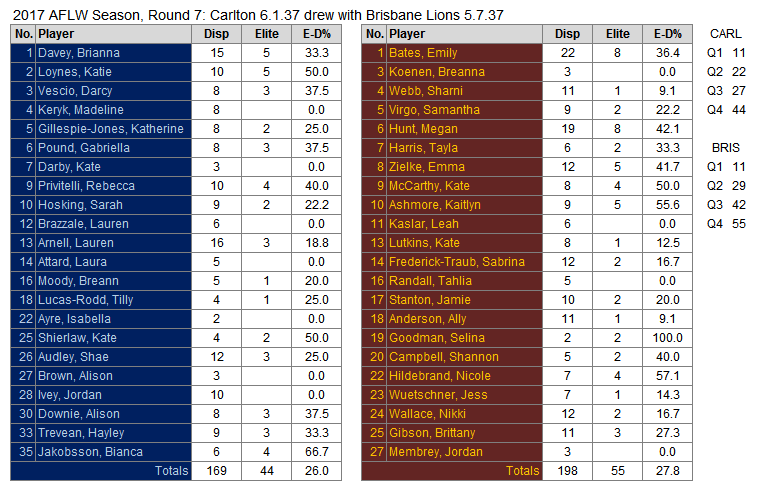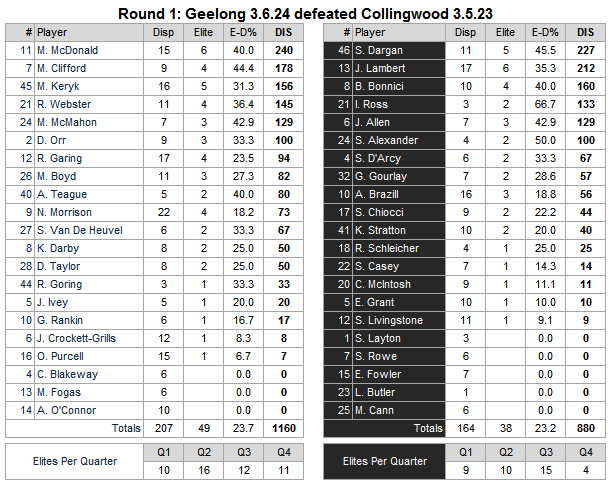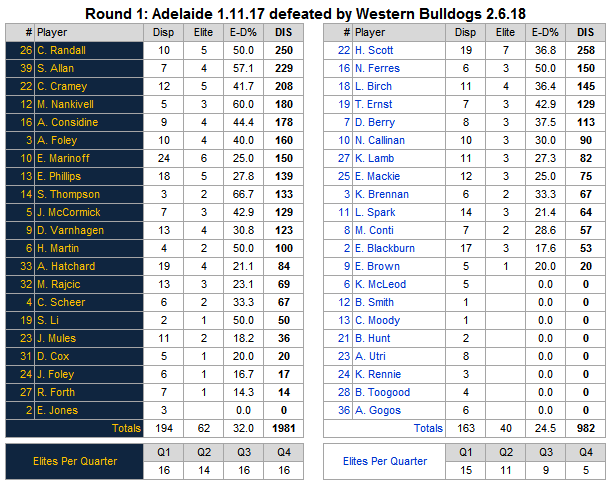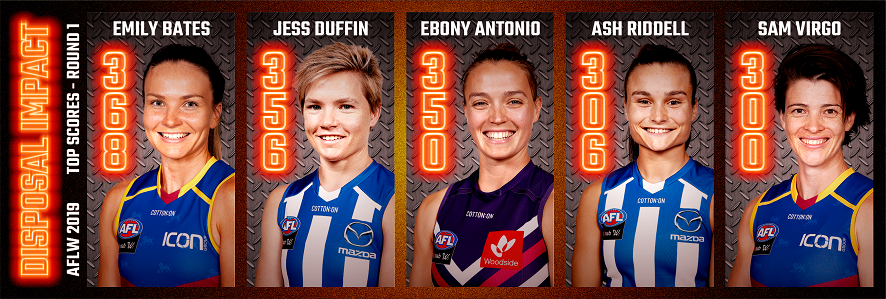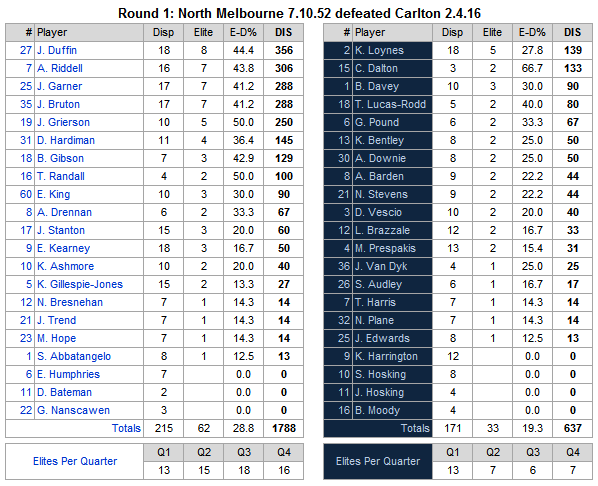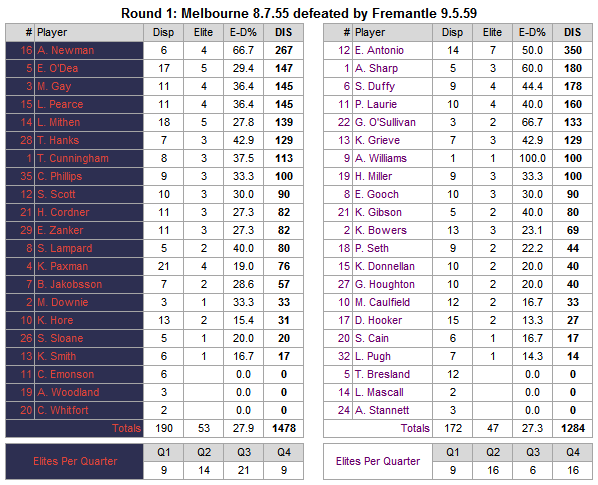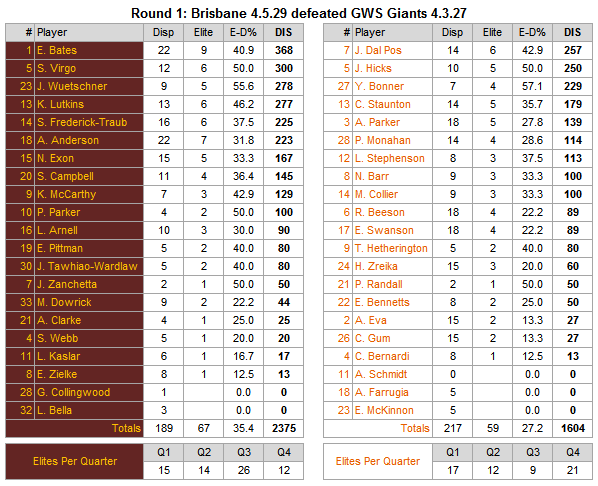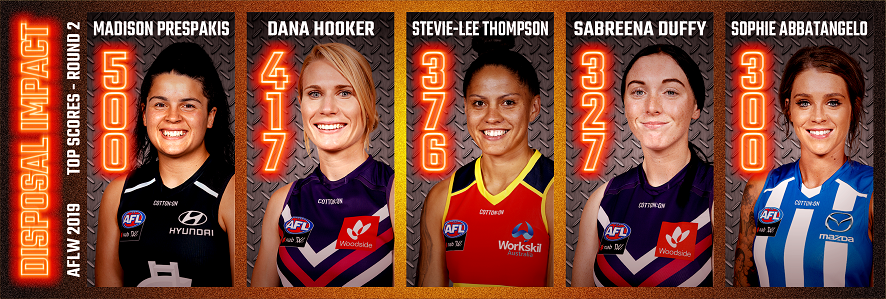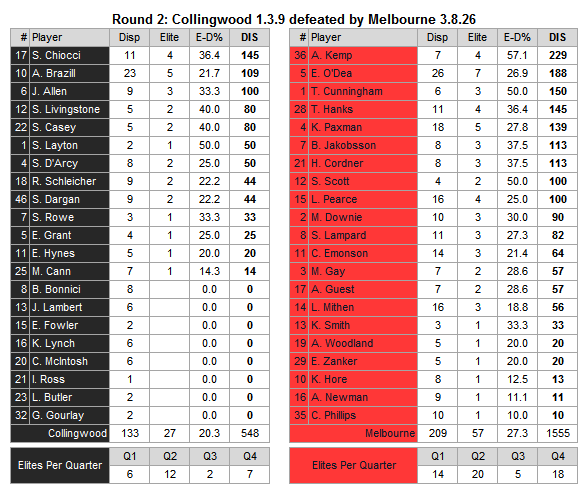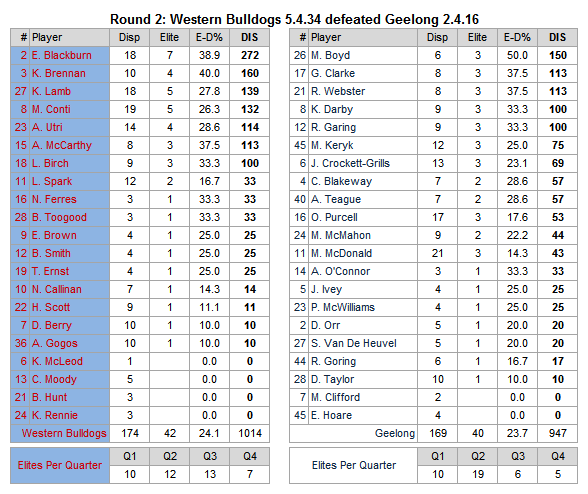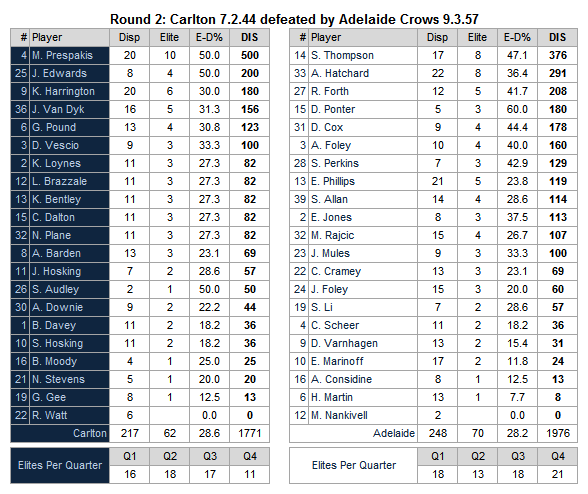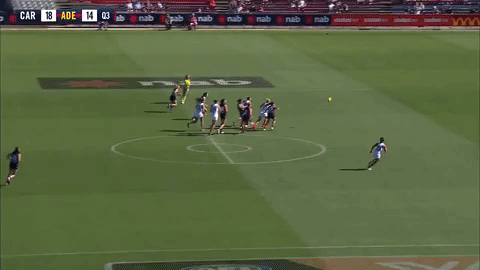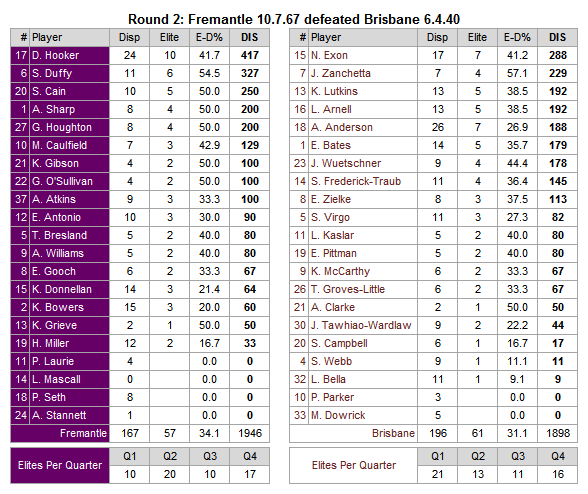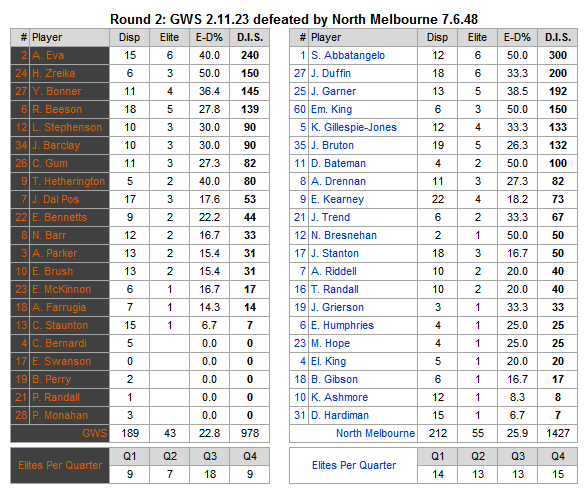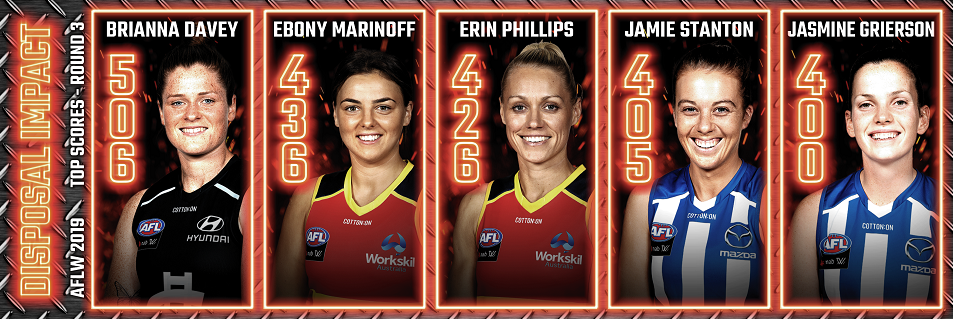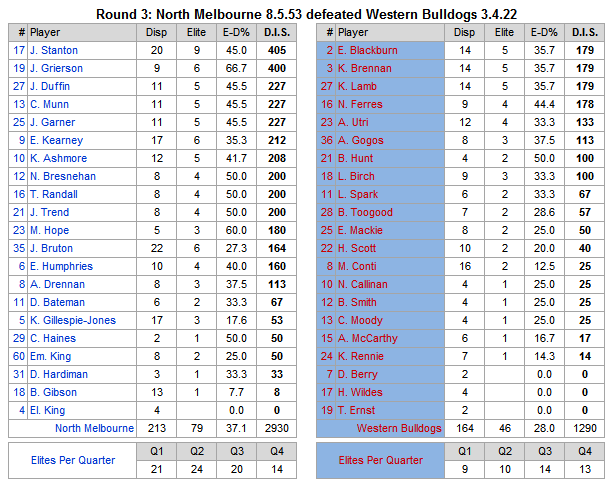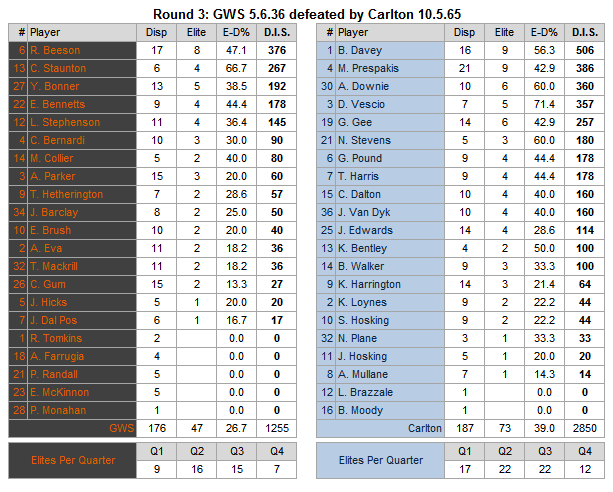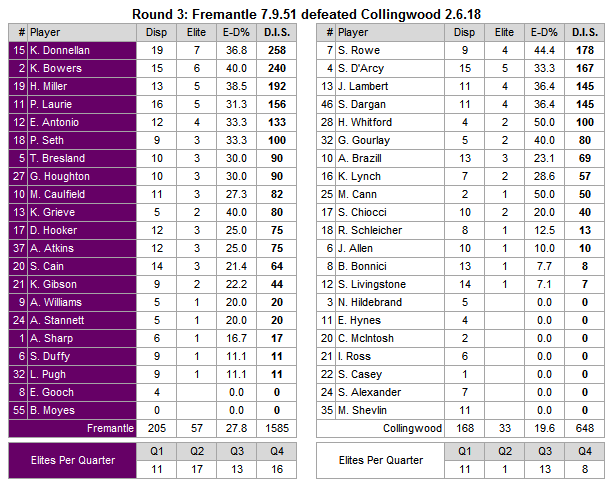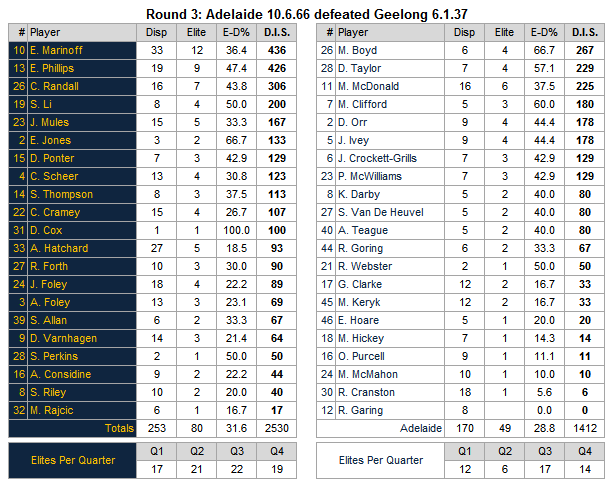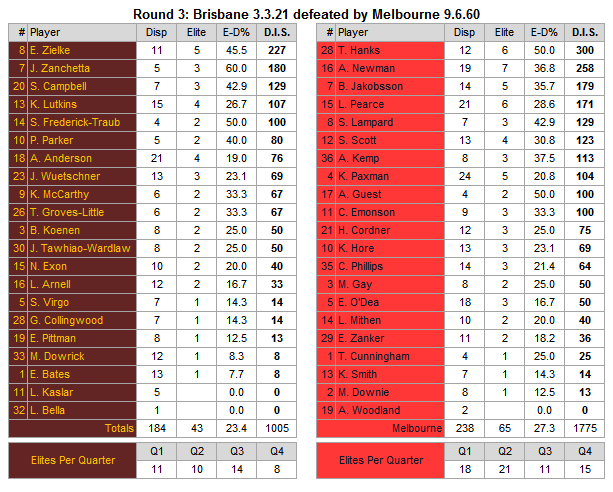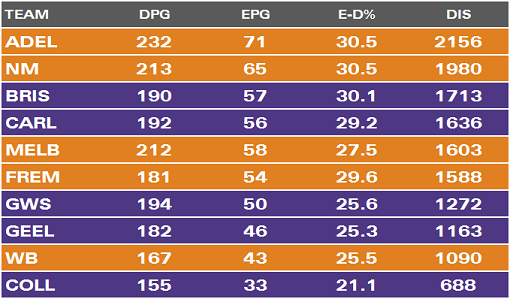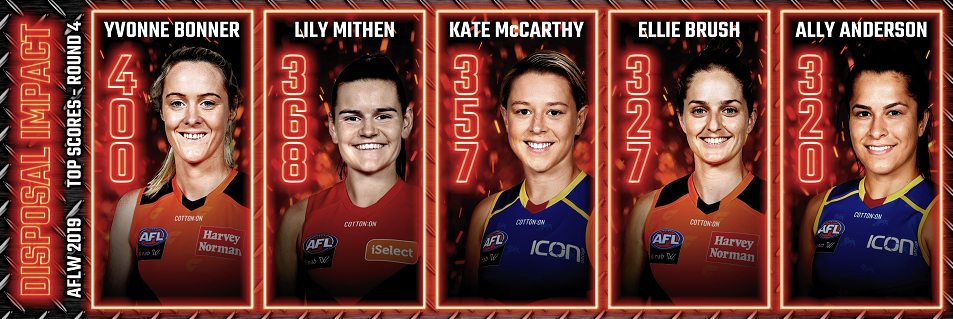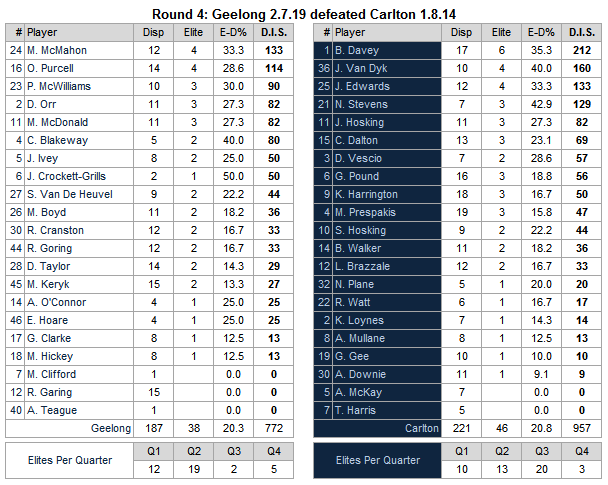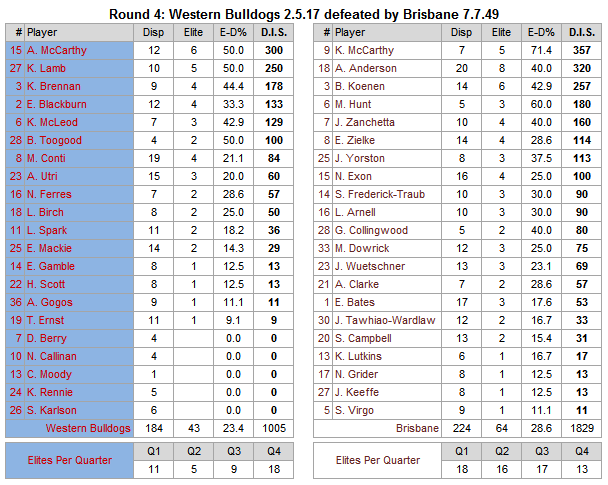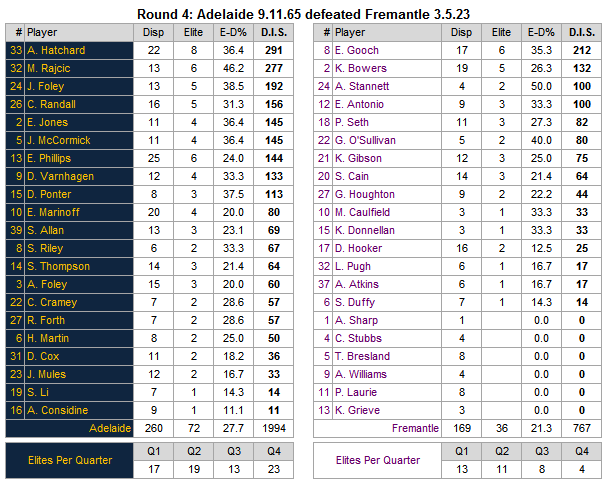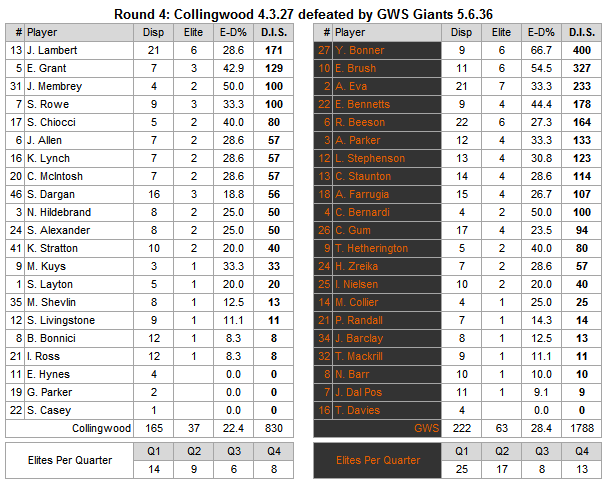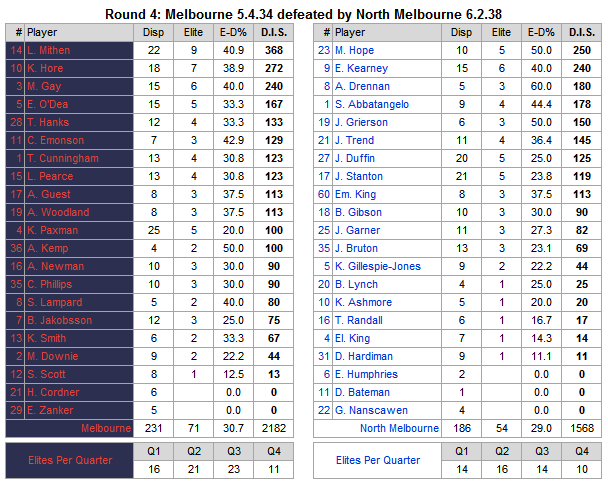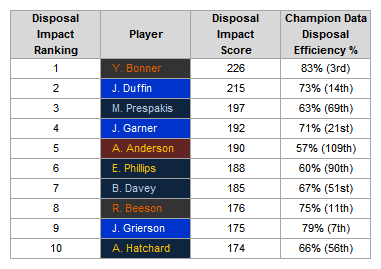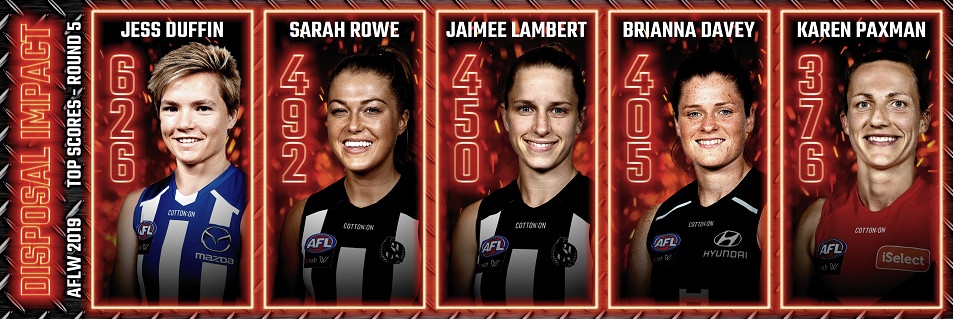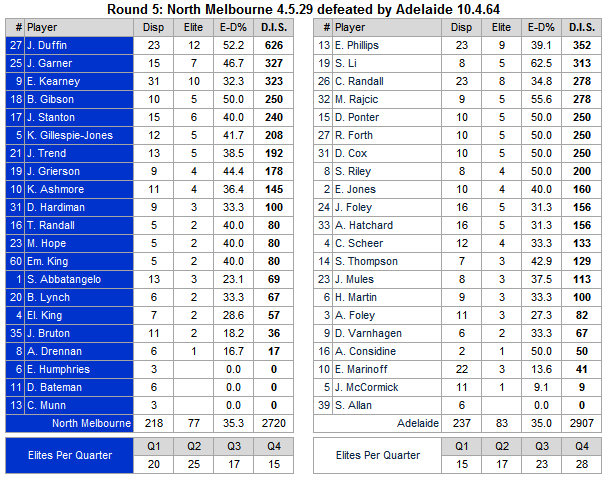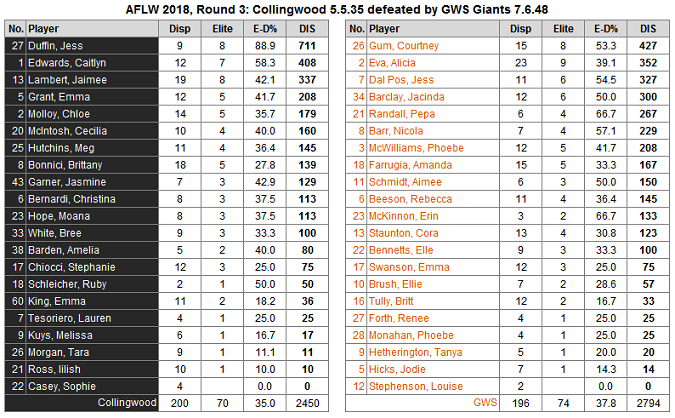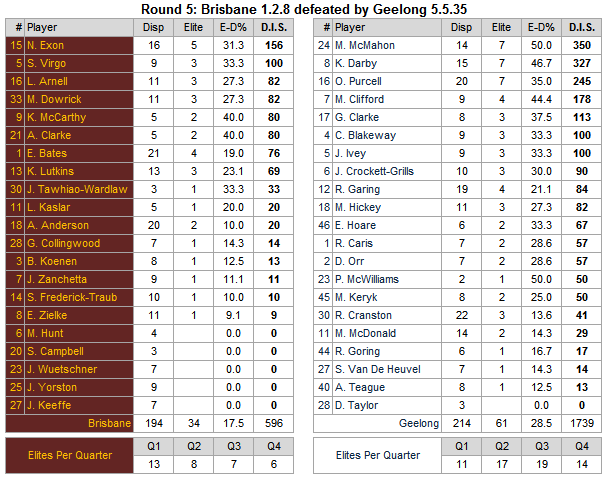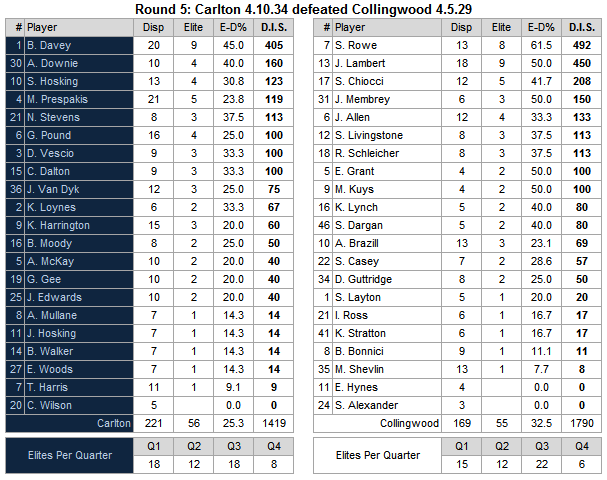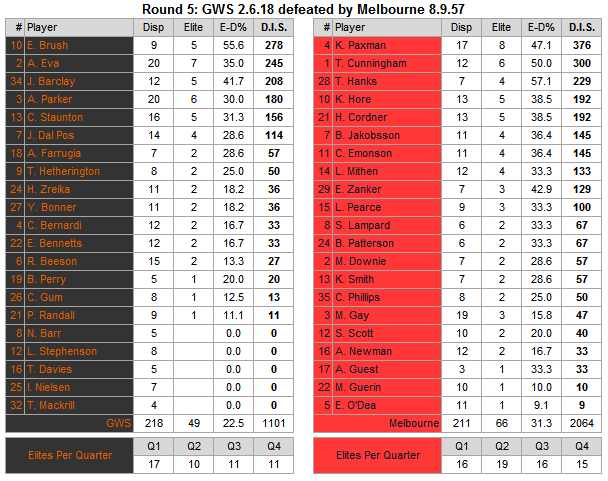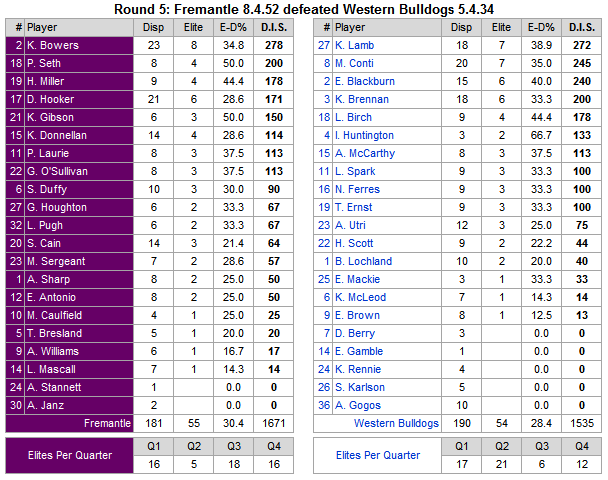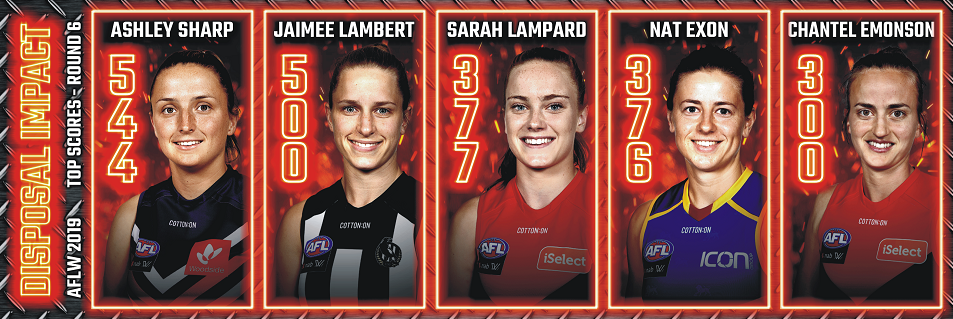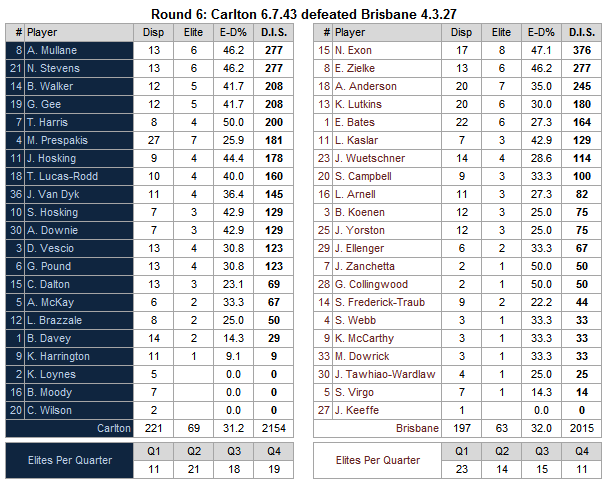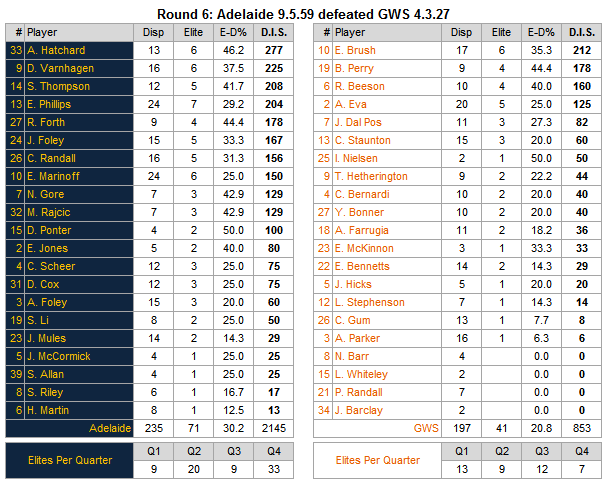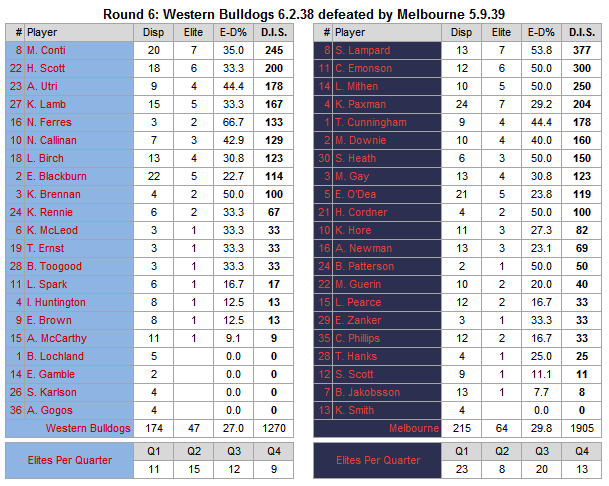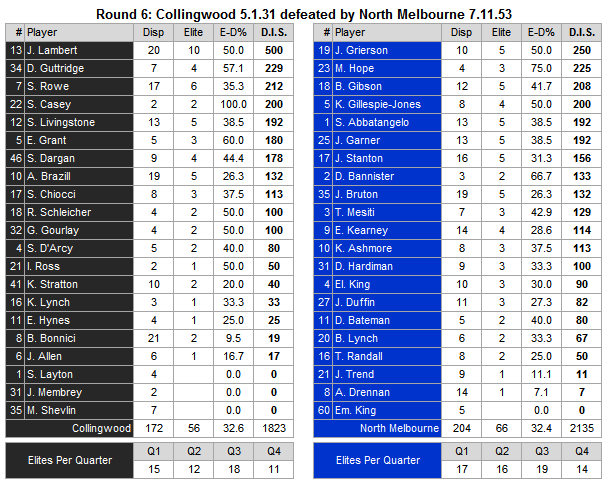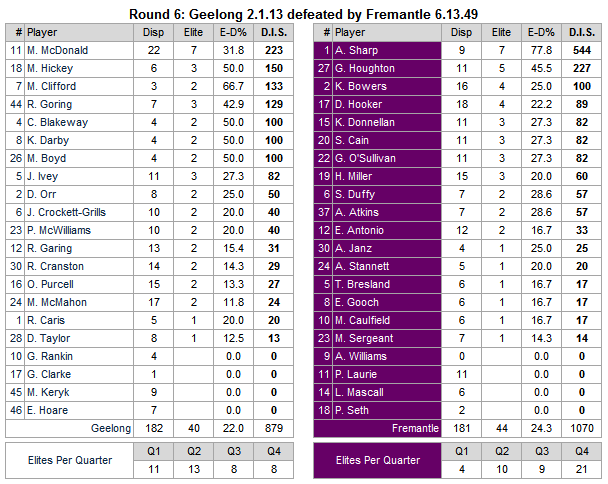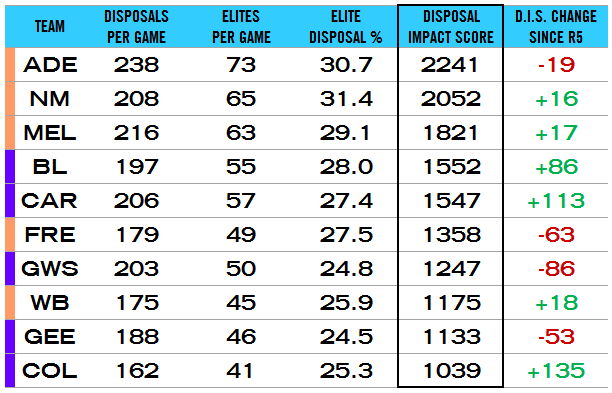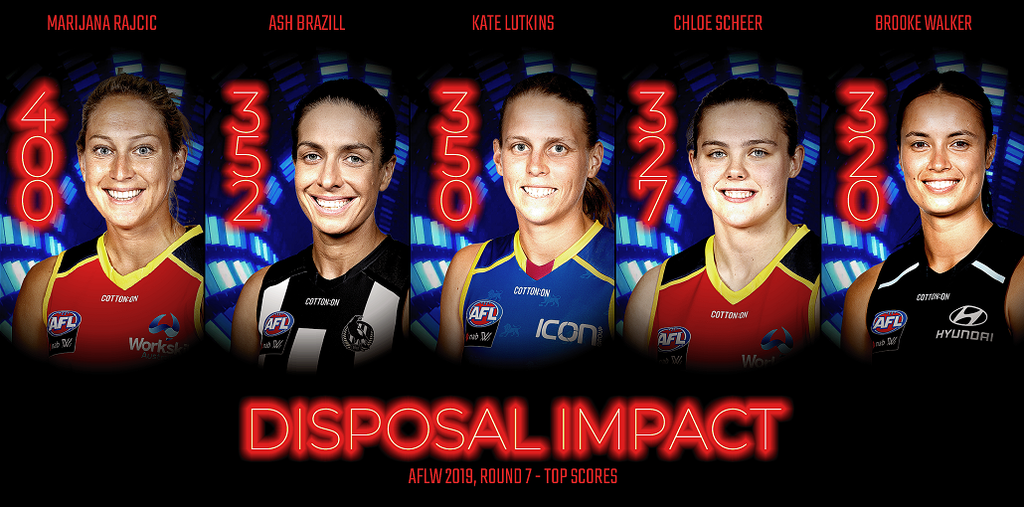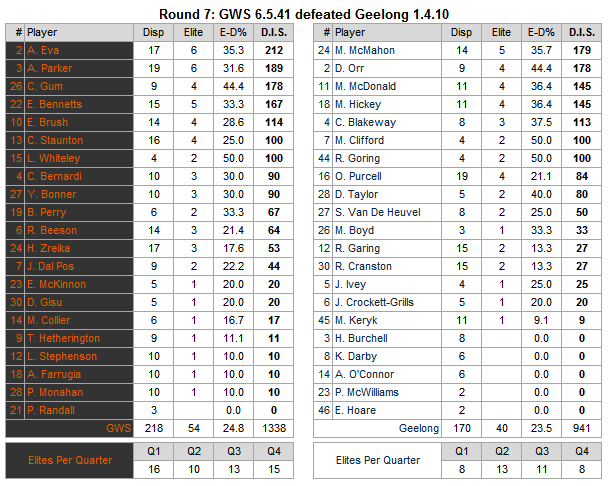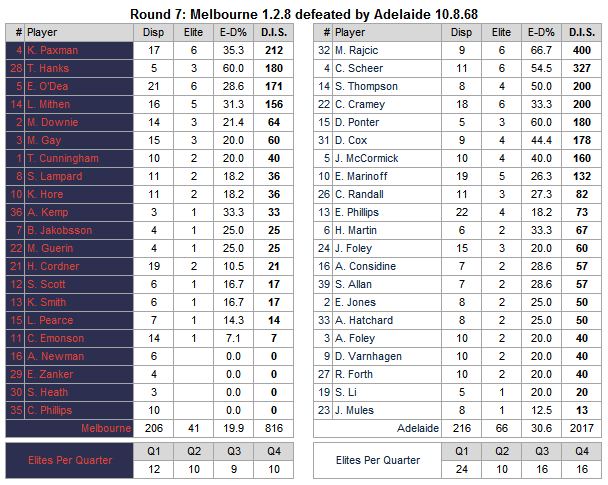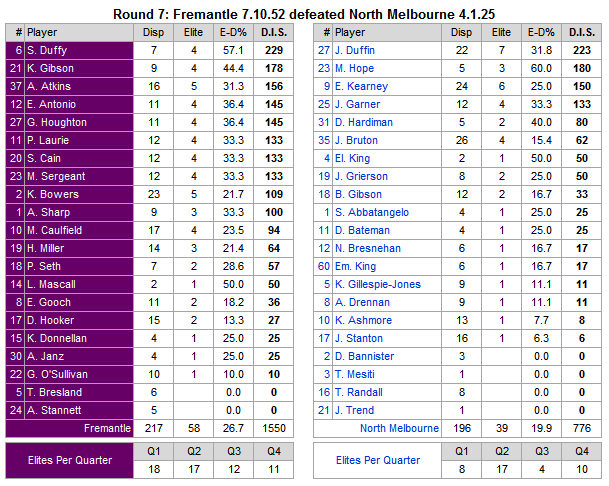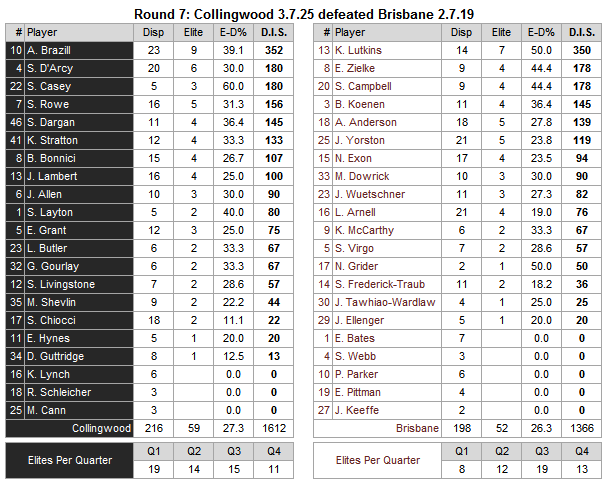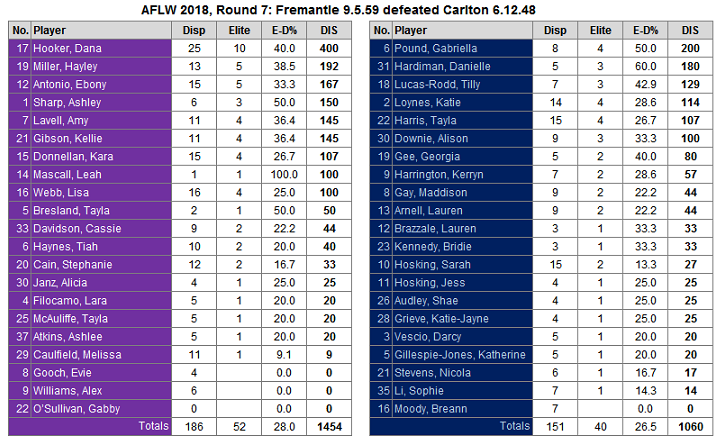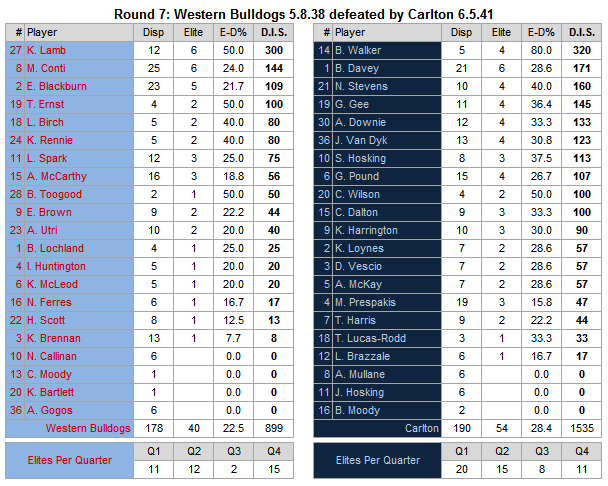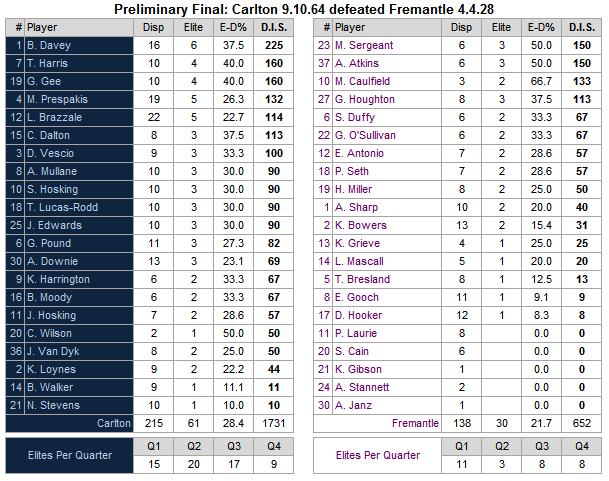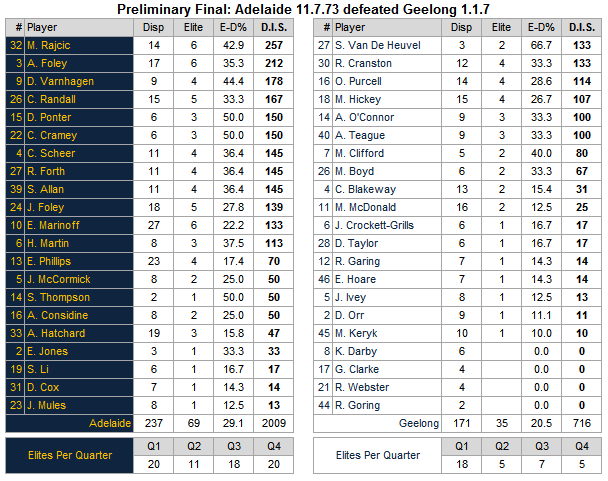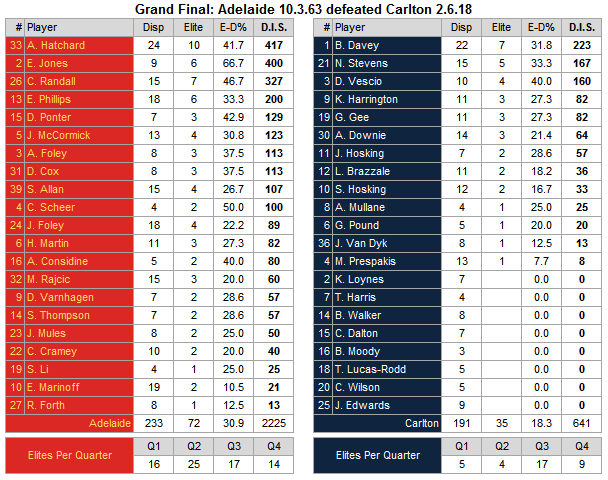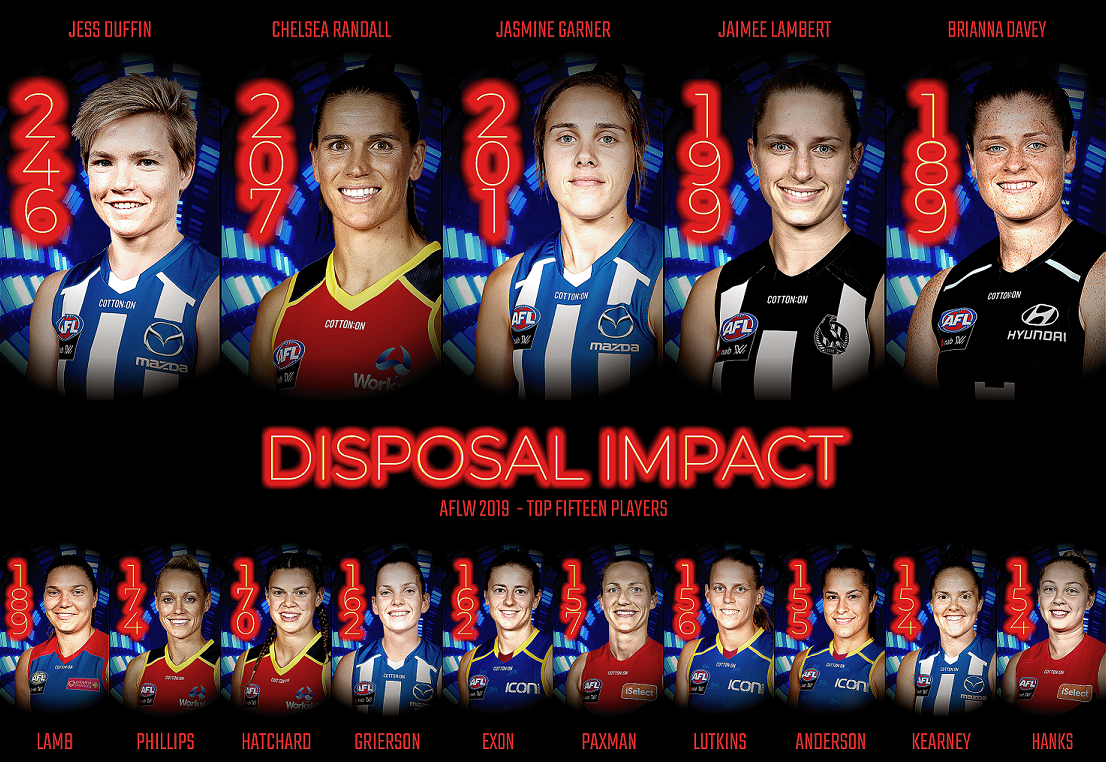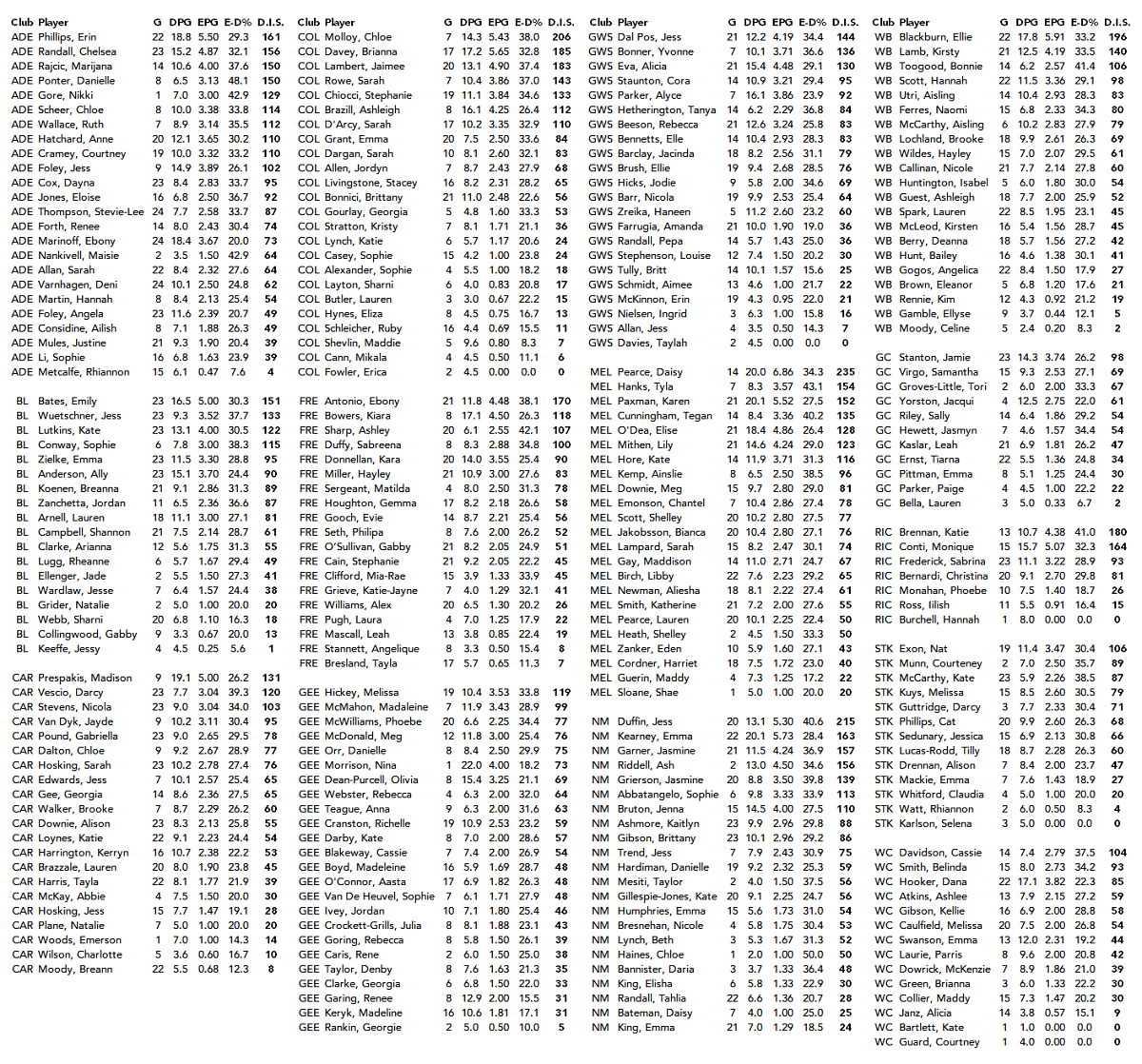Teen Wolf
Norm Smith Medallist
- Jul 5, 2011
- 8,113
- 8,919
- AFL Club
- North Melbourne
- Other Teams
- Afghanistan women's cricket team
When it comes to AFLW, a stat sorely in need of an overhaul is definitely Disposal Efficiency. It is often cited like a meaningful appraisal of a player's ability to use the ball for the benefit of their own team, but it clearly does no such thing.
Consider these season percentages from 2018:
Alicia Janz 86.2
Lauren Tesoriero 71.1
vs
Jess Wuetschner 59.7
Brooke Lochland 52.1
Without wanting to bash players, those laughable examples alone (not that I couldn't provide many more) undermine the integrity of the Disposal Efficiency stat as a whole. It is a flawed measurement with little relevance to the important moments happening on the ground, certainly not providing the information people ought to expect. It rewards hospital handpasses that aren't direct turnovers even if a fast break was squandered, and it approves of long kicks to a pack of players in the goalsquare even if there were three teammates free 20m out screaming for the pass. If the DE numbers are not always a misrepresentation, it's due to luck more than a competent system.
My solution is to apply stricter criteria based in the reality of how football games are won and lost. So, naturally, I went through all 58 games from the first two seasons and, as accurately as I could, gave one point to a player for every time they completed an Elite Disposal. If you’re even remotely familiar with AFL you know quality ball use when you see it, but for the sake of transparency I will attempt a definition in the spoiler below.
Also, see the following spoiler for an explanation of some terms and calculations that will be used in the tables below.
Now that team lists for next year are finalised, it's worth looking at each club and what my findings say about their pre-existing players.

Adelaide DIR Notes
Marinoff 79th in 2017, 162nd in 2018
Perkins 51st in 2017, 117th in 2018

Brisbane DIR Notes
Hunt 12th in 2017, 174th in 2018
McCarthy 23rd in 2017, 137th in 2018
Lutkins 105th in 2017, 16th in 2018
Koenen 106th in 2017, 37th in 2018
Anderson 179th in 2017, 40th in 2018

Carlton DIR Notes
Vescio 10th in 2017, 88th in 2018
Stevens 31st in 2017, 79th in 2018

Collingwood DIR Notes
Caitlyn Edwards (retired): 20*
Grant 28th in 2017, 106th in 2018

Fremantle DIR Notes
Lara Filocamo (delisted): 37*
Amy Lavell (retired): 37*

Geelong DIR Notes
Hickey 13th in 2017, 50th in 2018
McWilliams 35th in 2017, 101st in 2018

GWS DIR Notes
Eva 67th in 2017, 15th in 2018
Barr 88th in 2017, 46th in 2018
Farrugia 193rd in 2017, 65th in 2018


North Melbourne DIR Notes
Grierson 5th in 2017, 119th in 2018
Hope 76th in 2017, 36th in 2018

Western Bulldogs DIR Notes
Lochland 161st in 2017, 26th in 2018
Scott 69th in 2017, 20th in 2018
Berry 57th in 2017, 166th in 2018
McLeod 120th in 2017, 45th in 2018
Wildes 29th in 2017, 165th in 2018
Summaries of team performance for each season.
2017:

2018:

Based on those results, there's a decent argument to make about the connection between high DIS and successful teams. Something I'm even more convinced about is the connection to entertaining football. On top of that, the figures suggest a significant improvement across the league from the first season to the second.
Finally, for now at least, check out my workings below if you're feeling really nerdy.
2017, 1 to 106:

2017, 107 to 203:

2018, 1 to 112:

2018, 113 to 210:

Consider these season percentages from 2018:
Alicia Janz 86.2
Lauren Tesoriero 71.1
vs
Jess Wuetschner 59.7
Brooke Lochland 52.1
Without wanting to bash players, those laughable examples alone (not that I couldn't provide many more) undermine the integrity of the Disposal Efficiency stat as a whole. It is a flawed measurement with little relevance to the important moments happening on the ground, certainly not providing the information people ought to expect. It rewards hospital handpasses that aren't direct turnovers even if a fast break was squandered, and it approves of long kicks to a pack of players in the goalsquare even if there were three teammates free 20m out screaming for the pass. If the DE numbers are not always a misrepresentation, it's due to luck more than a competent system.
My solution is to apply stricter criteria based in the reality of how football games are won and lost. So, naturally, I went through all 58 games from the first two seasons and, as accurately as I could, gave one point to a player for every time they completed an Elite Disposal. If you’re even remotely familiar with AFL you know quality ball use when you see it, but for the sake of transparency I will attempt a definition in the spoiler below.
A disposal is classed as Elite if it fits any of the following:
^"Improved position" meaning further up the ground, except in the case of:
*"Opponent-eliminating" meaning:
- a controlled kick that should be marked by a teammate in an improved position^, or;
- a controlled opponent-eliminating* kick or handball that should be received by a teammate in an improved position^ without immediate defensive pressure, or;
- an opponent-eliminating* run-and-carry play concluding with a kick or handball to a 50-50 contest (or better) in an improved position^, or;
- a goal
^"Improved position" meaning further up the ground, except in the case of:
- a backwards or sideways disposal in defence with the intent and precision to allow for an effective switch, or;
- a backwards or sideways disposal in attack allowing for an easier shot at/approach to goal
*"Opponent-eliminating" meaning:
- an opposition player attempting to contest a disposal should be unable to contest the next disposal
Also, see the following spoiler for an explanation of some terms and calculations that will be used in the tables below.
The ratio of elite disposals to total disposals is expressed as E-D%. Par across the first two seasons is about 27-28, the higher the better.
DIS: Disposal Impact Score obtained by multiplying a player's EPG by their E-D%. Midfielders generally record a higher amount of elite disposals, but forwards generally record a better ratio of elite disposals. DIS is useful for comparing all kinds of players in terms of the influence their ball use has on a game.
DIR: Disposal Impact Ranking. Comparing a player's DIS with every other player in the league, a ranking of 1 being the best. Numbers with an asterisk are given in some instances, these indicate a player’s DIR if they were on an AFL list for 2019.
Also, like anything in this field, sample size matters. However, even after a few games I'd say players start settling into their groove. Double however, this isn't to say there weren't some wild fluctuations from season to season and I will make a note of some extreme ones below.
DIS: Disposal Impact Score obtained by multiplying a player's EPG by their E-D%. Midfielders generally record a higher amount of elite disposals, but forwards generally record a better ratio of elite disposals. DIS is useful for comparing all kinds of players in terms of the influence their ball use has on a game.
DIR: Disposal Impact Ranking. Comparing a player's DIS with every other player in the league, a ranking of 1 being the best. Numbers with an asterisk are given in some instances, these indicate a player’s DIR if they were on an AFL list for 2019.
Also, like anything in this field, sample size matters. However, even after a few games I'd say players start settling into their groove. Double however, this isn't to say there weren't some wild fluctuations from season to season and I will make a note of some extreme ones below.
Now that team lists for next year are finalised, it's worth looking at each club and what my findings say about their pre-existing players.
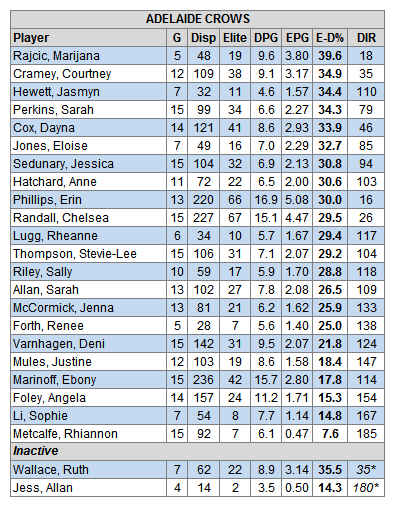
Adelaide DIR Notes
Marinoff 79th in 2017, 162nd in 2018
Perkins 51st in 2017, 117th in 2018
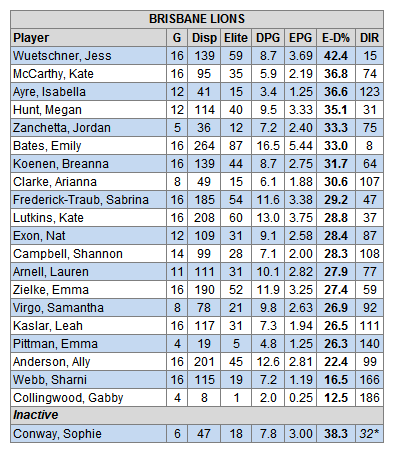
Brisbane DIR Notes
Hunt 12th in 2017, 174th in 2018
McCarthy 23rd in 2017, 137th in 2018
Lutkins 105th in 2017, 16th in 2018
Koenen 106th in 2017, 37th in 2018
Anderson 179th in 2017, 40th in 2018
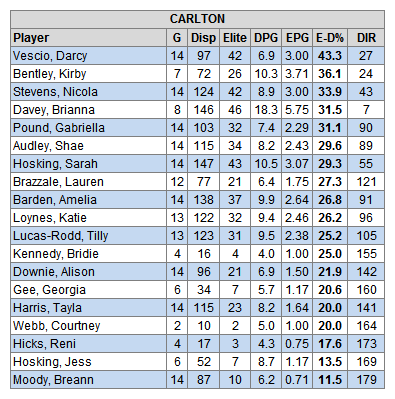
Carlton DIR Notes
Vescio 10th in 2017, 88th in 2018
Stevens 31st in 2017, 79th in 2018
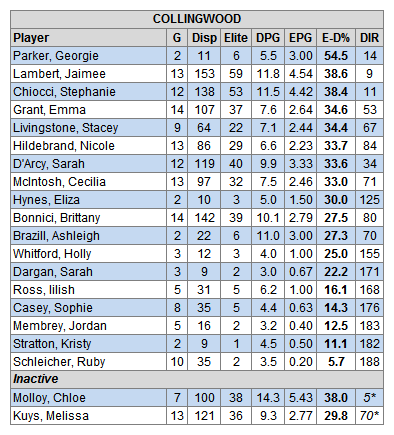
Collingwood DIR Notes
Caitlyn Edwards (retired): 20*
Grant 28th in 2017, 106th in 2018
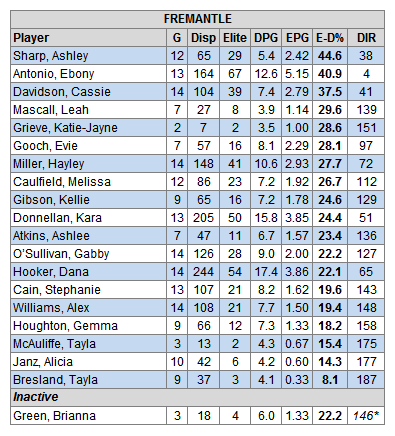
Fremantle DIR Notes
Lara Filocamo (delisted): 37*
Amy Lavell (retired): 37*
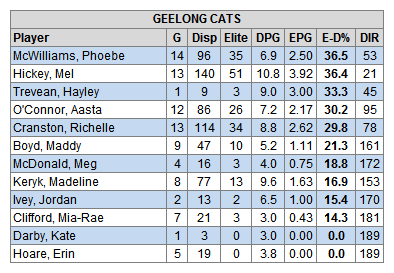
Geelong DIR Notes
Hickey 13th in 2017, 50th in 2018
McWilliams 35th in 2017, 101st in 2018
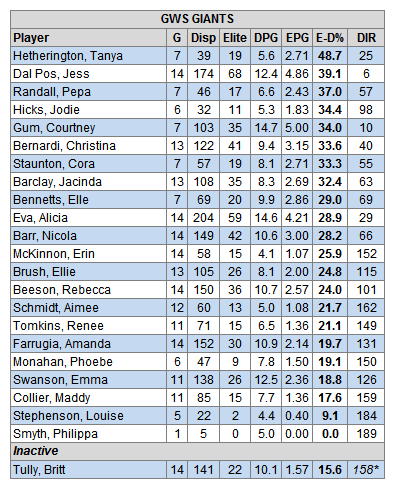
GWS DIR Notes
Eva 67th in 2017, 15th in 2018
Barr 88th in 2017, 46th in 2018
Farrugia 193rd in 2017, 65th in 2018
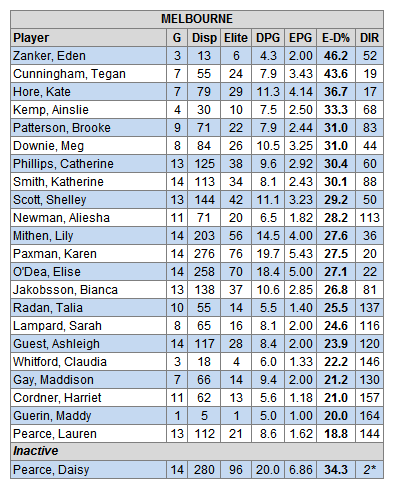
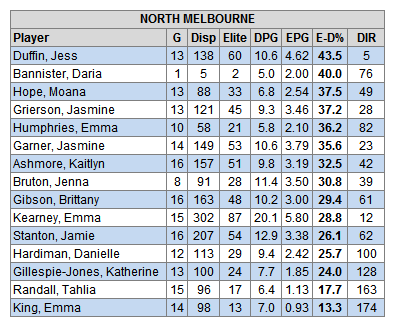
North Melbourne DIR Notes
Grierson 5th in 2017, 119th in 2018
Hope 76th in 2017, 36th in 2018
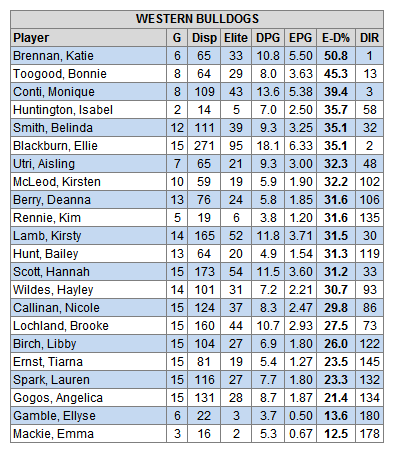
Western Bulldogs DIR Notes
Lochland 161st in 2017, 26th in 2018
Scott 69th in 2017, 20th in 2018
Berry 57th in 2017, 166th in 2018
McLeod 120th in 2017, 45th in 2018
Wildes 29th in 2017, 165th in 2018
Summaries of team performance for each season.
2017:
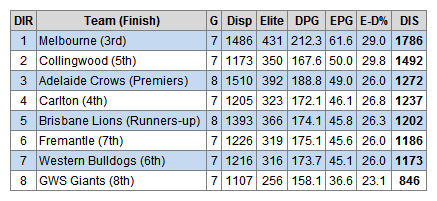
2018:
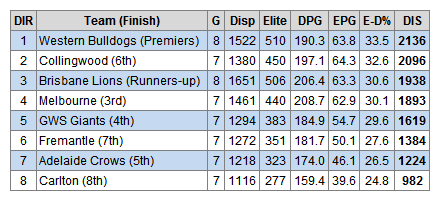
Based on those results, there's a decent argument to make about the connection between high DIS and successful teams. Something I'm even more convinced about is the connection to entertaining football. On top of that, the figures suggest a significant improvement across the league from the first season to the second.
Finally, for now at least, check out my workings below if you're feeling really nerdy.
2017, 1 to 106:
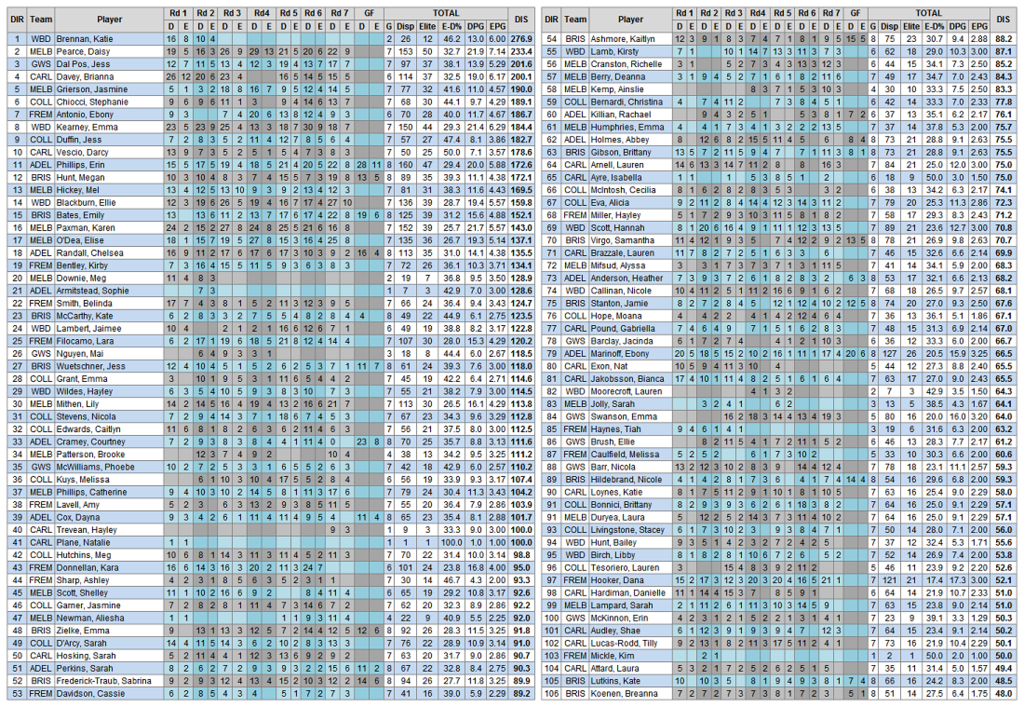
2017, 107 to 203:
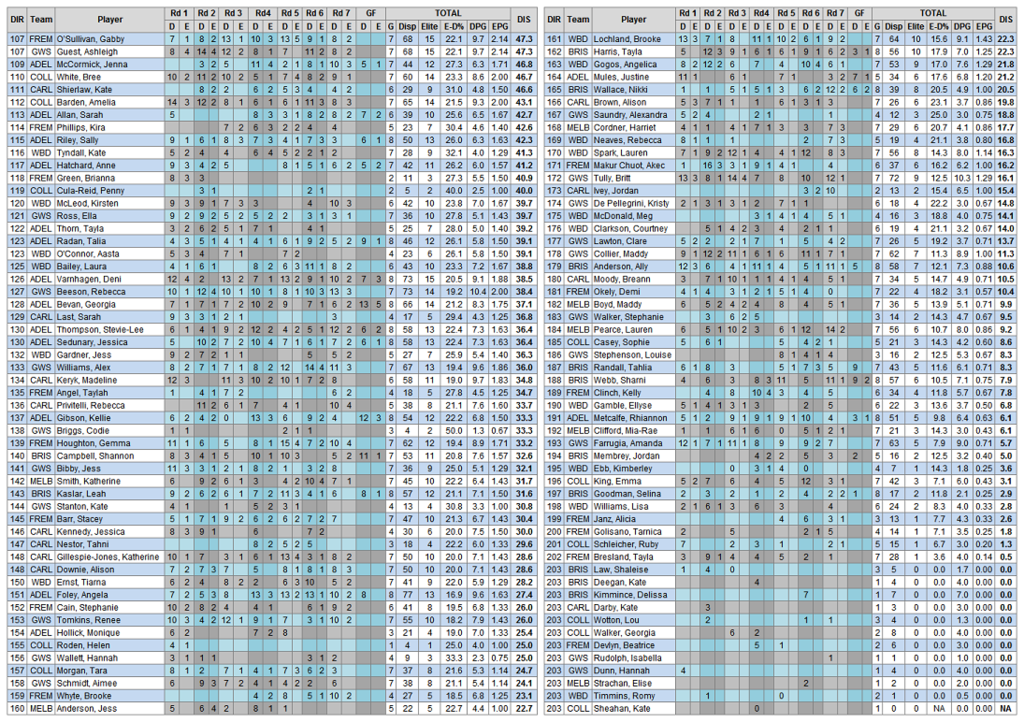
2018, 1 to 112:
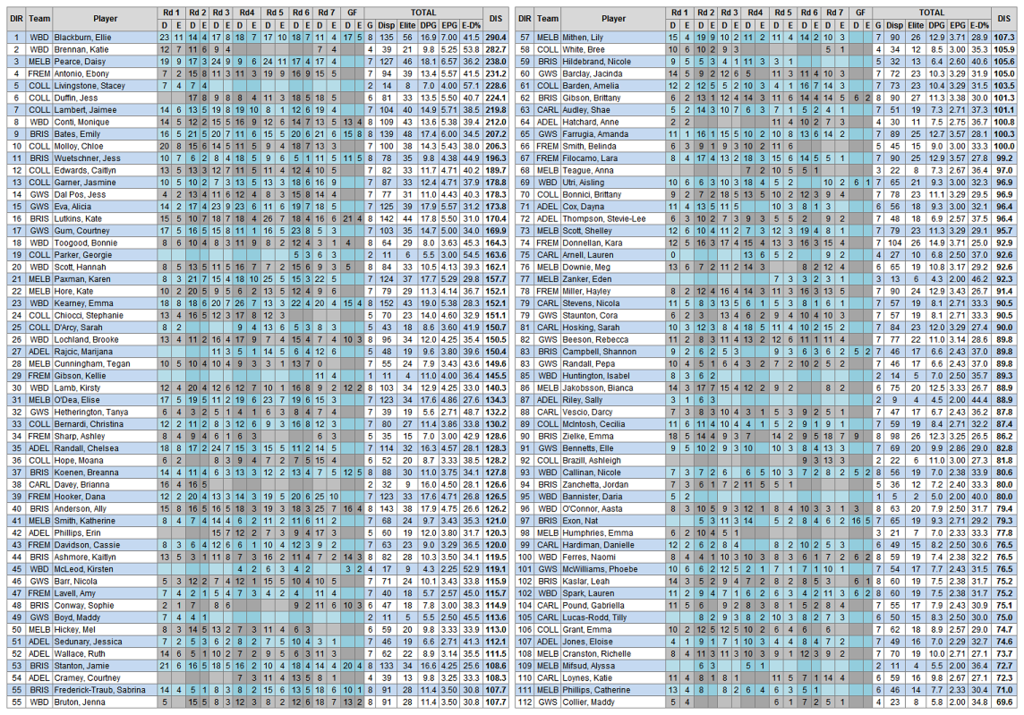
2018, 113 to 210:
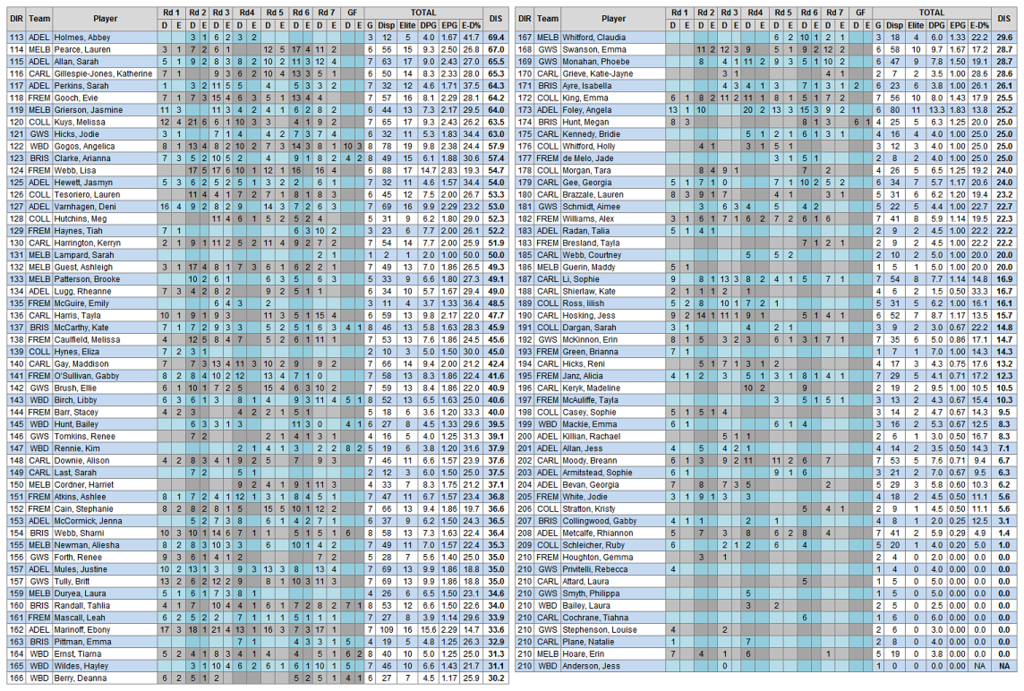
Last edited:



